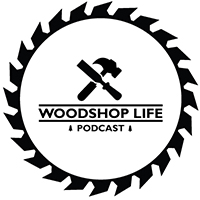This Weeks Questions
Brian:
Hey guys, I just discovered this podcast and have been thoroughly enjoying the episodes so far! I am a guitar technician by trade and recently started to build my own solid body electric guitar. I have been studying up on tool safety and learning proper technique, as a beginner I don’t want to develop any bad habits or unsafe practices. I used a router table when creating the guitar neck from a template, but if i’m being honest I am a bit intimidated by it and would prefer to start routing with a hand held router instead. As a guitar player and thumb wrestling aficionado, I would like to keep all of my digits where they belong! With that being said, I have a few questions I’d like to ask specific to hand routers:
1. When edge routing hardwood, is there anything I need to be aware of that would cause the router to suddenly jump or kickback? Can I do this with a trim router, or do I need a 2+HP router? I am using figured curly maple for the neck and alder for the body. Does that make a difference?
2. How much wood can I safety remove per pass? (The neck thickness is around 1” and the body thickness is around 1.75”)
3. Any techniques or advice on how to minimize chipping, tear out and router burn? i.e. speed of push, router bit speed
Jordan
What is all the fuss about french cleats? Have you guys used them in your shop? Are they the organizational panacea they are made out to be or is there a better way to use wall space to keep your shop neat and your tools accessible?
Evan
Guys Questions:
Hey guys, I have a question about finishing.
I am about to purchase a solid Mahogany entry door and I’d like to finish it myself. (Not so much “like” inasmuch save a grand) But I’m not quite sure what to use. I’ve asked professional painters and looked online but get a ton of different responses. I don’t really want to stain it but rather get a color from an oil finish like you’d get from waterlox or Odie’s. From all my research I’m leaning towards Total boat marine wood finish.
I live in the south suburbs of chicago and my door faces directly west. It is covered by about a 4’ over hang and I have a 30 year old oak in front so it wouldn’t see much direct Sun, rain or snow.
Hopefully you get to this in the next couple episodes as I think it’s about a 4 week lead time and we’re ordering it this week.
Thanks!
Kurt
Hi gentlemen,
I love your podcast! It really gets me through tough hump days at work and gets me excited to get back into the shop each weekend.
I typically create midcentury modern furniture or pieces that are unique and allow some creativity, but I’ve developed a side-side gig of cutting boards and such by request for business to business type orders. Recently, my day job (I’m in biomedical research) requested Missouri shaped plaques with logos and script for visiting keynote speakers. I’ve avoided the CNC and laser world as I prefer hand tool woodworking, but one or the other would be necessary for this project and presumably a great feature in the shop. I’ve done my research and still can’t decide.
This will be an ongoing order so I don’t want to be too cheap, but clearly not industrial due to space. What would you suggest? Diode seems limiting, but it would quickly pay off. CO2 sounds ideal, but pricey. CNC (Shark?) sounds more useful to my main hobby and I could cut out the state shape too. I usually believe in “pay once, cry once”, but this is a significant decision.
Deana from Pomegranate Studios
Huys Questions:
Hi. You have a great show. I’m ready to buy my first track saw and am looking at the Festool TS55. I’m looking for opinions on whether the cordless model is worth an extra $170 over the corded. In the shop with a dust extractor it seems like the cord is not much additional encumbrance. Outside the cordless with just the dust bag would be advantageous. Thanks, John
Hey guys, as always, I love the show and how you guys are able to provide excellent information from various perspectives. Today I would like to pick your brains about food safe finishes for a couple different situations. My wife bought me an outdoor pizza oven for my birthday, and because I’m a woodworker, I promptly threw out the wooden pizza peel that I’ve been using for years so that I could make one. My first attempt was with cherry and spalted maple. The maple ended up being much more punky than I had expected so I made a second one with cherry, hickory, and bubinga. What would you guys suggest for finishes? The peel will be going into a 700 degree oven, and I plan on repurposing the one with spalted maple to a charcuterie or serving platter, so it might have hot pizza on it, but I would like it to be sealed. Keep up the awesome podcast!
Josh from the Blackdog Woodworks
